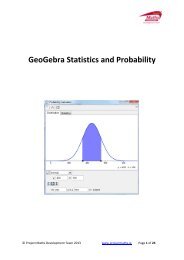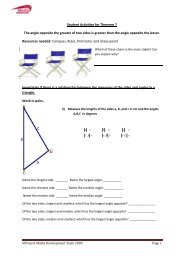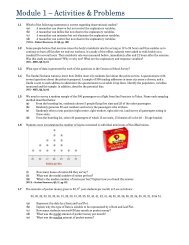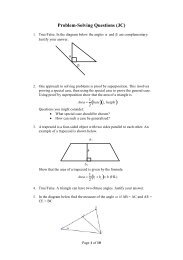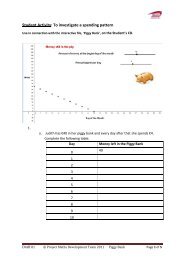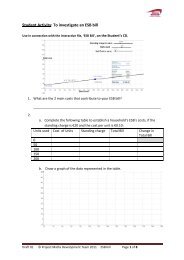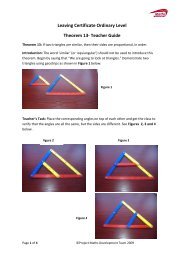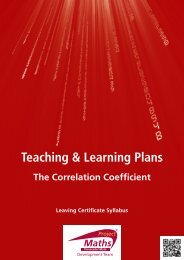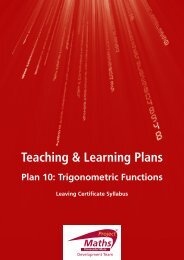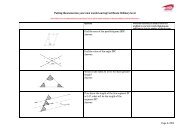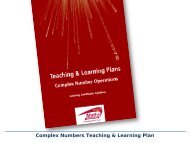Plan 3: Fair Trials with Two Dice - Project Maths
Plan 3: Fair Trials with Two Dice - Project Maths
Plan 3: Fair Trials with Two Dice - Project Maths
You also want an ePaper? Increase the reach of your titles
YUMPU automatically turns print PDFs into web optimized ePapers that Google loves.
Teaching & Learning <strong>Plan</strong>s<br />
<strong>Plan</strong> 3: <strong>Fair</strong> <strong>Trials</strong> <strong>with</strong> <strong>Two</strong> <strong>Dice</strong><br />
Leaving Certificate Syllabus
The Teaching & Learning <strong>Plan</strong>s<br />
are structured as follows:<br />
Aims outline what the lesson, or series of lessons, hopes to achieve.<br />
Prior Knowledge points to relevant knowledge students may already have and also<br />
to knowledge which may be necessary in order to support them in accessing this new<br />
topic.<br />
Learning Outcomes outline what a student will be able to do, know and understand<br />
having completed the topic.<br />
Relationship to Syllabus refers to the relevant section of either the Junior and/or<br />
Leaving Certificate Syllabus.<br />
Resources Required lists the resources which will be needed in the teaching and<br />
learning of a particular topic.<br />
Introducing the topic (in some plans only) outlines an approach to introducing the<br />
topic.<br />
Lesson Interaction is set out under four sub-headings:<br />
i. Student Learning Tasks – Teacher Input: This section focuses on teacher input<br />
and gives details of the key student tasks and teacher questions which move the<br />
lesson forward.<br />
ii.<br />
Student Activities – Possible and Expected Responses: Gives details of<br />
possible student reactions and responses and possible misconceptions students<br />
may have.<br />
iii. Teacher’s Support and Actions: Gives details of teacher actions designed to<br />
support and scaffold student learning.<br />
iv.<br />
Checking Understanding: Suggests questions a teacher might ask to evaluate<br />
whether the goals/learning outcomes are being/have been achieved. This<br />
evaluation will inform and direct the teaching and learning activities of the next<br />
class(es).<br />
Student Activities linked to the lesson(s) are provided at the end of each plan.
Teaching & Learning <strong>Plan</strong> 3:<br />
<strong>Fair</strong> <strong>Trials</strong> <strong>with</strong> <strong>Two</strong> <strong>Dice</strong><br />
Aims<br />
• To learn that not all results are equally probable<br />
• To consider a given set of rules and the outcomes that produce a ‘win’ for<br />
one of two players and to be able to determine whether the game is ‘fair’,<br />
i.e. whether each of the two players has the same chance of winning<br />
• To consider the theoretical probability of each result and devise a set of<br />
rules to make the game ‘fair’<br />
Prior Knowledge<br />
Students should have prior knowledge (from T and L <strong>Plan</strong> 1 and/or from primary school)<br />
of some terms associated <strong>with</strong> chance and uncertainty. They should be familiar <strong>with</strong><br />
probability expressed as fraction or decimal in the range 0 to 1, or as a percentage in<br />
the range 0% to 100%.<br />
Learning Outcomes<br />
As a result of studying this topic, students will be able to<br />
• investigate further what the concept of fairness means in a game <strong>with</strong> 2<br />
dice<br />
• list all the possible outcomes for throwing 2 dice using a two way table<br />
• relate the number of outcomes to the fundamental principle of counting<br />
• come up <strong>with</strong> rules for a game which make it fair/unfair<br />
• construct a probability table<br />
• understand the relationship between an event and its complement<br />
• determine the probability of an event using the results of an experiment<br />
and use this to predict the result of a repetition of the experiment, for<br />
equally likely outcomes<br />
© <strong>Project</strong> <strong>Maths</strong> Development Team 2009 www.projectmaths.ie 1
Teaching & Learning <strong>Plan</strong> 3: <strong>Fair</strong> <strong>Trials</strong> <strong>with</strong> <strong>Two</strong> <strong>Dice</strong><br />
Relationship to Leaving Certificate Syllabus<br />
Sub-topics<br />
Foundation<br />
Level<br />
1.1 Counting List outcomes of an<br />
experiment.<br />
1.2 Concepts of<br />
probability<br />
Discrete<br />
probability<br />
(as relative<br />
frequency)<br />
1.3 Outcomes<br />
of random<br />
processes<br />
Apply the<br />
fundamental<br />
principle of<br />
counting.<br />
Recognise that<br />
probability is a<br />
measure on a scale<br />
of 01- of how likely<br />
an event is to occur.<br />
Probability of<br />
desired outcomes in<br />
problems involving<br />
experiments, such<br />
as, dice throwing.<br />
Apply the principle<br />
that, in the case<br />
of equally likely<br />
outcomes, the<br />
probability is given<br />
by the number<br />
of outcomes of<br />
interest divided by<br />
the total number of<br />
outcomes.<br />
Ordinary Level<br />
Count the<br />
arrangements of<br />
distinct objects.<br />
Recognise the role<br />
of expected value<br />
in decision making<br />
<strong>with</strong> a focus on fair<br />
games.<br />
Higher Level<br />
Extend the<br />
students’<br />
understanding of<br />
the basic rules of<br />
probability.<br />
Resources Required<br />
Counters, 2 dice and a Game Sheet for each pair of students<br />
© <strong>Project</strong> <strong>Maths</strong> Development Team 2009 www.projectmaths.ie 2
© <strong>Project</strong> <strong>Maths</strong> Development Team 2009 www.projectmaths.ie KEY: » next step • student answer/response 3<br />
Teaching & Learning <strong>Plan</strong> 3: <strong>Fair</strong> <strong>Trials</strong> <strong>with</strong> <strong>Two</strong> <strong>Dice</strong><br />
Student Learning Tasks:<br />
Teacher Input<br />
»» In each group of two, one<br />
person is nominated as A<br />
and one as B. Players A<br />
and B take turns to roll<br />
the die, and the winner is<br />
determined by the sum of<br />
the numbers on the faces<br />
as follows:<br />
»» Students A and B<br />
alternately roll the die,<br />
each time adding the<br />
scores on each die to get<br />
the outcome. They place a<br />
counter on each outcome.<br />
Student Activities: Possible<br />
and Expected Responses<br />
Lesson Interaction<br />
Teacher’s Support and<br />
Actions<br />
»»<br />
Distribute Student Activity<br />
1 so that students can write<br />
their prediction (Student<br />
Activity 1A) and keep a<br />
count of the number of<br />
times each player wins<br />
(Student Activity 1B).<br />
»» Distribute counters and<br />
Game Sheet 1 and dice to<br />
each pair, checking that<br />
students have a written<br />
prediction and a reason for<br />
it.<br />
Checking Understanding<br />
»» Can students record their<br />
initial results in their<br />
copies<br />
»»<br />
A wins if sum (i.e. outcome)<br />
is 2, 3, 4, 10, 11 or 12.<br />
»» B wins if sum i.e. is 5, 6,<br />
7, 8, 9. Play the game on<br />
Game Sheet 1.<br />
»» Think about this for a few<br />
minutes and write down<br />
which player you think will<br />
win the game most often if<br />
it is played many times, and<br />
why you think this.<br />
»» Students may think that<br />
since 11 numbers have<br />
been listed, and since A<br />
can win on 6 of these and<br />
B only on 5, that A is more<br />
likely to win than B.<br />
»» Ask for a show of hands on<br />
who thinks A will win and<br />
who thinks B will win.
© <strong>Project</strong> <strong>Maths</strong> Development Team 2009 www.projectmaths.ie KEY: » next step • student answer/response 4<br />
Teaching & Learning <strong>Plan</strong> 3: <strong>Fair</strong> <strong>Trials</strong> <strong>with</strong> <strong>Two</strong> <strong>Dice</strong><br />
Student Learning Tasks:<br />
Teacher Input<br />
»» The game is played until<br />
one person has reached<br />
the bottom of the grid on<br />
Game Sheet 1 and students<br />
count the number of times<br />
A won and the number of<br />
times B won and fill out<br />
the Master Sheet on the<br />
board also.<br />
Student Activities: Possible<br />
and Expected Responses<br />
»» The students should find<br />
that A wins only about 1/3<br />
of the time.<br />
Teacher’s Support and<br />
Actions<br />
»» Check that each pair<br />
understands what they are<br />
doing and occasionally,<br />
as you circulate, ask<br />
“hands up how many A’s<br />
are winning” and then<br />
“hands up how many B’s<br />
are winning” so students<br />
are aware of an overall<br />
trend.<br />
Checking Understanding<br />
»» Were students able<br />
to conduct the game<br />
successfully and did they<br />
notice B winning much<br />
more often<br />
»» How many students in the<br />
class were able to make<br />
accurate predictions <strong>with</strong><br />
valid reasons<br />
»»<br />
Place Master Sheet 1<br />
(results from the whole<br />
class) on the board.<br />
»»<br />
Did they react to this as<br />
being unfair<br />
»» When you are finished fill<br />
out Student Activity 1B<br />
and fill in your results on<br />
Master Sheet 1 (results<br />
from the whole class) on<br />
the board.<br />
»» Students check this against<br />
their prediction, analysing<br />
any difference and fill in<br />
Student Activity 1C.<br />
»» The relative frequency is<br />
now closer to 1/3.<br />
»» As you circulate check<br />
predictions against<br />
outcomes of the<br />
experiment, and ask<br />
students about their<br />
justifications.<br />
»» Which number on each<br />
die cannot be a possible<br />
outcome<br />
• “1 “can never be an<br />
outcome as the smallest<br />
sum possible is 2.<br />
»»<br />
Does this game appear to<br />
be fair<br />
• No. <strong>Fair</strong> – if A and B have<br />
an equal chance of winning<br />
otherwise unfair.<br />
»» Give students a minute to<br />
think and then ask one<br />
student.
© <strong>Project</strong> <strong>Maths</strong> Development Team 2009 www.projectmaths.ie KEY: » next step • student answer/response 5<br />
Teaching & Learning <strong>Plan</strong> 3: <strong>Fair</strong> <strong>Trials</strong> <strong>with</strong> <strong>Two</strong> <strong>Dice</strong><br />
Student Learning Tasks:<br />
Teacher Input<br />
» Why is it not fair<br />
Student Activities: Possible<br />
and Expected Responses<br />
•<br />
can only be got 1 way (1+1)<br />
whereas 9 for example can<br />
be got from (3+6), (4+5).<br />
» Students might say that 2<br />
Teacher’s Support and<br />
Actions<br />
»» Give students a minute to<br />
think and then ask one<br />
student.<br />
Checking Understanding<br />
»» Do students understand<br />
the concept of fairness<br />
• All outcomes are not<br />
equally likely.<br />
»»<br />
Is the outcome 4+5 the<br />
same as the outcome 5+4<br />
• No, because the first time<br />
4 is from die 1 and the<br />
second time it’s from die 2.<br />
»» Give students a minute to<br />
think and then ask one<br />
student.<br />
»»<br />
In how many ways could an<br />
outcome of 9 be achieved<br />
• 4+5<br />
• 5+4<br />
• 3+6<br />
• 6+3<br />
»» Give students a minute to<br />
think and then ask one<br />
student.<br />
»» Could you design a table to<br />
show you all the possible<br />
outcomes.<br />
»» The set of all the possible<br />
outcomes is called the<br />
‘Sample Space’.<br />
»»<br />
Try this for a few minutes.<br />
»» Some students will<br />
probably come up <strong>with</strong> the<br />
2 way table and show it to<br />
the class.<br />
»» Circulate looking at<br />
student suggestions and<br />
giving helpful hints. On<br />
finding a suitable table<br />
ask students to show and<br />
explain it to the class.<br />
Students may need help<br />
designing the table.<br />
»» How many of the students<br />
were able to come up <strong>with</strong><br />
a suitable table<br />
»» Individually, fill in the<br />
2-way table for the sample<br />
space for the sum achieved<br />
on throwing 2 dice<br />
(Student Activity 2A).<br />
»» Students fill up the table<br />
as per example in Student<br />
Activity 2A.<br />
»»<br />
Distribute Student Activity<br />
2.<br />
»» Circulate to check that<br />
students understand how<br />
to fill it in.<br />
»» Are all students able to fill<br />
in the table successfully<br />
and <strong>with</strong> understanding
© <strong>Project</strong> <strong>Maths</strong> Development Team 2009 www.projectmaths.ie KEY: » next step • student answer/response 6<br />
Teaching & Learning <strong>Plan</strong> 3: <strong>Fair</strong> <strong>Trials</strong> <strong>with</strong> <strong>Two</strong> <strong>Dice</strong><br />
Student Learning Tasks:<br />
Teacher Input<br />
»» How many possible<br />
outcomes are there<br />
Student Activity 2B.<br />
»» Can you relate this back to<br />
the fundamental principle<br />
of counting in a previous<br />
lesson<br />
»» Going back to the rules of<br />
the game, for how many<br />
outcomes will player A<br />
win and for how many<br />
outcomes will player B<br />
win Student Activity 2C.<br />
»» Go back to your prediction<br />
again, Student Activity 1C,<br />
and if it was not consistent<br />
<strong>with</strong> the outcome write<br />
down why it was different.<br />
Student Activities: Possible<br />
and Expected Responses<br />
36.<br />
Teacher’s Support and<br />
Actions<br />
»»<br />
answers being filled in,<br />
asking questions where<br />
necessary.<br />
»» Ask the question and wait<br />
for someone to volunteer<br />
an answer. If it’s the same<br />
person answering all the<br />
time, ask another student,<br />
leading them to the<br />
answer if they don’t know<br />
it, by referring back to an<br />
example they did when<br />
learning the fundamental<br />
principle of counting.<br />
• Circulate and look at the<br />
• If there are 6 different<br />
outcomes from die 1,<br />
and 6 different outcomes<br />
from die 2, then the<br />
total number of possible<br />
outcomes is 6x6 = 36.<br />
• 12 of the 36 outcomes give<br />
a win for A whereas 24 of<br />
the outcomes give a win<br />
for B.<br />
»» Students articulate their<br />
misconceptions.<br />
»» Circulate and note<br />
misconceptions, and ask a<br />
selection of students who<br />
thought A would win to<br />
explain why they thought<br />
that and why they now<br />
think differently.<br />
Checking Understanding<br />
»» Have students been able<br />
to recall and use the<br />
fundamental principle of<br />
counting<br />
»» Are students able to<br />
understand in cases where<br />
their predictions were in<br />
error why this was so
© <strong>Project</strong> <strong>Maths</strong> Development Team 2009 www.projectmaths.ie KEY: » next step • student answer/response 7<br />
Teaching & Learning <strong>Plan</strong> 3: <strong>Fair</strong> <strong>Trials</strong> <strong>with</strong> <strong>Two</strong> <strong>Dice</strong><br />
Student Learning Tasks: Teacher Input Student Activities:<br />
Possible and Expected<br />
Responses<br />
»» Write down new rules for the game, »» Different groups<br />
»»<br />
Student Activity 2D, which will make<br />
it fair and an explanation of why it is<br />
now fair.<br />
Is more than one set of rules possible<br />
»» The approach in Teaching & Learning<br />
<strong>Plan</strong> 2, and above in Student Activity<br />
1B, is known as the ‘experimental’ or<br />
‘empirical’ approach to calculating<br />
probabilities. In this case the<br />
probability of an event is the value that<br />
the relative frequency tends to in an<br />
infinite number of trials.<br />
»» In the theoretical approach, when<br />
throwing a die, there are six possible<br />
outcomes which are all equally likely<br />
to appear due to the symmetry of<br />
the die, and given that it is a fair die<br />
(not loaded) so we have no reason to<br />
assume that any number will appear<br />
more often than another. A2 is one<br />
of the 6 possible outcomes, so the<br />
likelihood of it turning up is 1 out of<br />
6.<br />
present their new rules<br />
for class approval.<br />
• For example. Player A<br />
wins if the outcome is<br />
2, 3, 4, 5, 8 or 10 and B<br />
wins if the outcome is<br />
6, 7, 9, 11 or 12.<br />
Teacher’s Support and<br />
Actions<br />
»» Circulate and when<br />
groups are finished ask<br />
a couple of groups to<br />
explain their new rules.<br />
Checking Understanding<br />
»» Are students able to<br />
make up more than one<br />
set of rules satisfying<br />
the criterion for a fair<br />
game
© <strong>Project</strong> <strong>Maths</strong> Development Team 2009 www.projectmaths.ie KEY: » next step • student answer/response 8<br />
Teaching & Learning <strong>Plan</strong> 3: <strong>Fair</strong> <strong>Trials</strong> <strong>with</strong> <strong>Two</strong> <strong>Dice</strong><br />
Student Learning Tasks:<br />
Teacher Input<br />
»» What is the relationship<br />
between the experimental<br />
approach to calculating<br />
probability and the<br />
theoretical approach<br />
»» How do we calculate the<br />
theoretical probability<br />
of each outcome in this<br />
sample space<br />
»» What assumption are we<br />
making<br />
»» Are all 36 outcomes equally<br />
likely here<br />
»» Construct a probability<br />
table (Student Activity 3)<br />
for the sum of 2 dice using<br />
Student Activity 2A.<br />
»» Assuming that both of the<br />
dice are fair, and all 36<br />
outcomes are equally likely,<br />
what is the probability of<br />
the sum being 5<br />
»» What is the sum of the<br />
probabilities for the sample<br />
space<br />
Student Activities: Possible<br />
and Expected Responses<br />
• As the number of trials<br />
increases the relative<br />
frequency becomes almost<br />
equal to the theoretical<br />
probability.<br />
• How many times it<br />
occurs divided by the<br />
total number of possible<br />
outcomes.<br />
• All outcomes are equally<br />
likely.<br />
• Yes.<br />
Teacher’s Support and<br />
Actions<br />
»» Asks students to recall and<br />
then after a short pause<br />
asks an individual.<br />
»» Walk around observing<br />
students as they fill out the<br />
probability table.<br />
• Using the 2 way table<br />
(Student Activity 2A)<br />
showing the sample space<br />
constructed for the game,<br />
there are 4 outcomes for<br />
5, so the probability of<br />
getting a 5 is 4/36.<br />
• 1<br />
»» Ask students if they<br />
remember this happening<br />
in the last lesson <strong>with</strong><br />
outcomes from 1 die<br />
Checking Understanding<br />
»» Can students recall how to<br />
calculate probability for<br />
equally likely outcomes<br />
»» Did students fill out the<br />
table correctly<br />
»» Did all students get 1
© <strong>Project</strong> <strong>Maths</strong> Development Team 2009 www.projectmaths.ie KEY: » next step • student answer/response 9<br />
Teaching & Learning <strong>Plan</strong> 3: <strong>Fair</strong> <strong>Trials</strong> <strong>with</strong> <strong>Two</strong> <strong>Dice</strong><br />
Student Learning Tasks:<br />
Teacher Input<br />
»» If the probability of getting<br />
a 3 is 2/36, what is the<br />
probability of not getting a<br />
3 <strong>with</strong>out adding up all the<br />
other probabilities Write<br />
down the answer.<br />
»» Going back to the original<br />
rules for the game, what<br />
is the probability that A<br />
wins<br />
»»<br />
Fill in answer on Student<br />
Activity 3.<br />
»» Use the probability that<br />
A wins to calculate the<br />
probability that B wins,<br />
<strong>with</strong>out adding.<br />
»»<br />
Fill in answer on Student<br />
Activity 3.<br />
»» Compare this <strong>with</strong><br />
experimental result for<br />
relative frequency.<br />
»»<br />
Fill in answer on Student<br />
Activity 3.<br />
Student Activities: Possible<br />
and Expected Responses<br />
1-2/36=34/36<br />
Teacher’s Support and<br />
Actions<br />
»»<br />
answer <strong>with</strong>out adding up<br />
all the other probabilities,<br />
tell them to do that first<br />
and then see if they can<br />
then find the other way by<br />
inspecting their answer.<br />
»»<br />
difficulty: ask them to<br />
count how many of the<br />
outcomes give A a win, and<br />
how many outcomes are<br />
there in total.<br />
• If a student cannot get the<br />
• 12/36=1/3<br />
For students who have<br />
• 1-1/3=2/3<br />
»» If a student cannot get the<br />
answer <strong>with</strong>out adding up<br />
all the other probabilities,<br />
tell them to do that first<br />
and then see if they can<br />
then find the other way by<br />
inspecting their answer.<br />
• They are very close and the »» Circulate checking that<br />
relative frequency becomes Student Activity 3 is<br />
closer to the theoretical being completed, asking<br />
probability as the number questions of students who<br />
of games increases.<br />
are having difficulty.<br />
Checking Understanding<br />
»» How many students got<br />
the correct answer <strong>with</strong>out<br />
having to add up all the<br />
other probabilities<br />
»» Do students understand<br />
the relationship between<br />
an event and its<br />
complement<br />
»» Do students see that<br />
the experimental results<br />
approach the theoretical<br />
values for probability as<br />
the number of games<br />
increases
© <strong>Project</strong> <strong>Maths</strong> Development Team 2009 www.projectmaths.ie KEY: » next step • student answer/response 10<br />
Teaching & Learning <strong>Plan</strong> 3: <strong>Fair</strong> <strong>Trials</strong> <strong>with</strong> <strong>Two</strong> <strong>Dice</strong><br />
Student Learning Tasks:<br />
Teacher Input<br />
»» If the probability of a sum<br />
of 7 occurring is 6/36=1/6,<br />
how many 7’s would you<br />
expect to get if the dice are<br />
tossed 100 times<br />
Reflection<br />
»» Write down 3 things you<br />
learned about probability<br />
today.<br />
Student Activities: Possible<br />
and Expected Responses<br />
• 100x1/6 i.e. approx 17<br />
(1/6 of the time you expect<br />
a 7.)<br />
• How to:<br />
1. list all possible outcomes<br />
(sample space) for<br />
throwing 2 dice<br />
2. use the list of all possible<br />
outcomes to judge fairness<br />
3. construct a probability<br />
table<br />
4. calculate the complement<br />
of an event<br />
5. calculate expected value<br />
for a large number of trials.<br />
Teacher’s Support and<br />
Actions<br />
»» Emphasise that you are<br />
dealing <strong>with</strong> equally likely<br />
outcomes.<br />
»» Circulate and take<br />
note particularly of any<br />
questions students have<br />
and help them to answer<br />
them.<br />
Checking Understanding<br />
»» Can students calculate an<br />
expected value for a large<br />
number of trials<br />
»» Have all students learned<br />
and understood these<br />
items<br />
»» Are they using the<br />
terminology <strong>with</strong><br />
understanding and<br />
communicating <strong>with</strong> each<br />
other using these terms<br />
»»<br />
»»<br />
Write down anything you<br />
found difficult.<br />
Write down any questions<br />
you may have.
Teaching & Learning <strong>Plan</strong> 3: <strong>Fair</strong> <strong>Trials</strong> <strong>with</strong> <strong>Two</strong> <strong>Dice</strong><br />
Game Sheet 1<br />
A wins A wins A wins B wins B wins B wins B wins B wins A wins A wins A wins<br />
1 2 3 4 5 6 7 8 9 10 11 12<br />
© <strong>Project</strong> <strong>Maths</strong> Development Team 2009 www.projectmaths.ie 11
Teaching & Learning <strong>Plan</strong> 3: <strong>Fair</strong> <strong>Trials</strong> <strong>with</strong> <strong>Two</strong> <strong>Dice</strong><br />
Student Activity 1<br />
Player _____ will win most often because:<br />
Student Activity 1A<br />
Prediction<br />
Student Activity 1B<br />
Play the game and record the results below:<br />
Player A Wins<br />
Use Tally Marks to Help<br />
You Keep a Score<br />
Total (Frequency)<br />
Relative Frequency<br />
(total no. of wins/total<br />
no. of games)<br />
Player B Wins<br />
Totals<br />
Student Activity 1C<br />
Did your predicted results agree <strong>with</strong> your actual results<br />
© <strong>Project</strong> <strong>Maths</strong> Development Team 2009 www.projectmaths.ie 12
Teaching & Learning <strong>Plan</strong> 3: <strong>Fair</strong> <strong>Trials</strong> <strong>with</strong> <strong>Two</strong> <strong>Dice</strong><br />
Master Sheet 1<br />
(Results from the Whole Class)<br />
Play the game and record the results below:<br />
Player A Wins 2+3+...<br />
Use Tally Marks to Help<br />
You Keep a Score<br />
Total (Frequency)<br />
Relative Frequency<br />
(total no. of wins/total<br />
no. of games)<br />
Player B Wins<br />
Totals<br />
© <strong>Project</strong> <strong>Maths</strong> Development Team 2009 www.projectmaths.ie 13
Teaching & Learning <strong>Plan</strong> 3: <strong>Fair</strong> <strong>Trials</strong> <strong>with</strong> <strong>Two</strong> <strong>Dice</strong><br />
Student Activity 2<br />
Student Activity 2A<br />
Complete the table to show all of the possible outcomes.<br />
<strong>Two</strong> way table showing the sample space.<br />
Number<br />
thrown<br />
1 2 3 4 5 6<br />
1 1+1=2<br />
2<br />
3<br />
4<br />
5 5+2=7<br />
6<br />
Student Activity 2B<br />
How many possible outcomes are there__________________<br />
Student Activity 2C<br />
Original Rules: Player A wins when the sum is 2, 3, 4, 10, 11 or 12.<br />
Player B wins when the sum is 5, 6, 7, 8 or 9.<br />
For how many outcomes will player A win__________________<br />
For how many outcomes will player B win__________________<br />
Student Activity 2D<br />
New Rules:<br />
Player A wins when the sum is __________________________<br />
Why I chose these new rules:<br />
Player B wins when the sum is __________________________<br />
© <strong>Project</strong> <strong>Maths</strong> Development Team 2009 www.projectmaths.ie 14
Teaching & Learning <strong>Plan</strong> 3: <strong>Fair</strong> <strong>Trials</strong> <strong>with</strong> <strong>Two</strong> <strong>Dice</strong><br />
Student Activity 3<br />
Sum Frequency Probability<br />
no. of outcomes in the event<br />
=<br />
no. of outcomes in the sample event<br />
2 1<br />
1<br />
36<br />
3<br />
4<br />
5<br />
6<br />
7<br />
8<br />
9<br />
10<br />
11<br />
12<br />
© <strong>Project</strong> <strong>Maths</strong> Development Team 2009 www.projectmaths.ie 15



